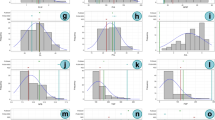Summary
The objective of the present study was to investigate the genetic architecture of yield in diverse populations of rice. Multivariate analysis by Mahalanobis's D2 statistic and canonical (vector) analysis revealed that panicle weight, days to maturity, plant height and seed size were the important forces contributing towards divergence. One hundred rice strains were grouped into nine clusters with the help of D2 and canonical analysis. The grouping pattern of the varieties were quite at random indicating that the geographical and genetic diversity were not related.
Similar content being viewed by others
References
Arunachalam V (1967) Computer programmes for some problems in biometrical genetics. 2. Use of canonical variates in deriving group constellations. Indian J Genet 27:70–79
Arunachalam V, Ram J (1967) Geographical diversity in relation to genetic divergence in cultivated sorghum. Indian J Genet 27:369–380
Chandersekhariah SR, Murty BR, Arunachalam V (1969) Multivariate analysis of genetic divergence in Eu-Sorghum. Proc Nat Inst Sci India 35:172–192
Dhawan NL, Singh J (1961) Flint and Dent maize hybrids give increased yield. Curr Sci 30:233–234
Hargrove TR (1979) Diffusion and adoption of semi dwarf rice cultivars and parents in Asian rice. Crop Sci 19:571–574
Hargrove TR, Cabanilla VL (1979) The impact of semi dwarf rice varieties in Asian rice breeding programme. Biosciences 29:731–735
Hargrove TR, Coffman WR, Cabanilla VL (1979) Genetic interrelationship of improved rice varieties in Asia. IRRI Research Paper 23
Matzinger DF, Mann TJ, Cockerham CC (1962) Diallel crosses in Nicotiana tobacum. Crop Sci 2:283–286
Moll RH, Salhuna WS, Robinson HF (1962) Heterosis and genetic diversity in variety crosses of maize. Crop Sci 2:197–199
Murty BR (1979) Selection of parental material, breeding methods and evaluation procedures in developing crop varieties. Indian J Genet 39:305–314
Murty BR, Arunachalam V (1966) The nature of divergence in relation to breeding systems in some crop plants. Indian J Genet 26A:188–198
Narsinghani VG, Kanwal KS, Singh SP (1978) Genetic divergence in peas. Indian J Genet 38:375–379
National Academy of Sciences (1972) Genetic vulnerability of food crops. Washington DC
Rao CR (1952) Advanced statistical methods in biometrical research. John Wiley & Sons, New York
Sethi GS, Asawa BM, Singh HB (1978) Genetic divergence in triple dwarf wheat. Indian J Agric Sci 48:445–447
Singh VP, Swaminathan MS, Mehra BR, Siddiq EA (1979) Divergence among the dwarfs of cultivated rice. Indian J Genet 39:315–322
Timothy DH (1963) Genetic diversity, heterosis and use of exotic collections in maize in Columbia. Symp Statistic Genet Plant Breed. Raleigh NC, pp 84–92
Vairavan S, Siddiq EA, Arunachalam V, Swaminathan MS (1973) A study in the genetic divergence in rice from North-East Himalaya. Theor Appl Genet 43:213–221
Author information
Authors and Affiliations
Additional information
Communicated by G. S. Khush
Rights and permissions
About this article
Cite this article
Kanwal, K.S., Singh, R.M. & Singh, J. Divergent gene pools in rice improvement. Theoret. Appl. Genetics 65, 263–267 (1983). https://doi.org/10.1007/BF00308077
Received:
Issue Date:
DOI: https://doi.org/10.1007/BF00308077




